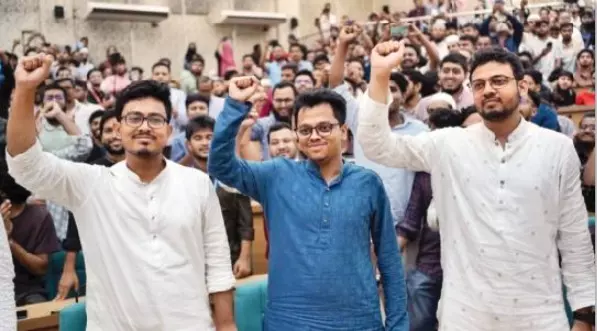Bangladesh’s ‘New’ Student Force
The banned student wing of Jamaat-e-Islami has made a powerful comeback, harnessing post-uprising disillusionment and a divided opposition to sweep university elections across Bangladesh

Islami Chhatra Shibir (ICS), widely accepted as an anti-liberation force in Bangladesh due to its affiliations with Jamaat-e-Islami (JeI) and historical opposition to the 1971 Liberation War, has long operated on the fringes of mainstream politics. Renamed in 1977 at Dhaka University’s mosque during the Ziaur Rahman era, Shibir faced bans and restrictions for decades. In 1990, following the fall of Ershad, Dhaka University authorities and student representatives imposed a ban on Shibir’s activities. This persisted through the Bangladesh Nationalist Party (BNP) and Awami League (AL) governments, culminating in a formal ban under the Anti-Terrorism Act on August 1, 2024, by the Sheikh Hasina government. However, the present interim government lifted this ban on August 28, 2024, allowing Shibir to re-emerge.
Significantly, the fall of the Hasina government in July 2024, amid the student-led uprising, marked a turning point. Shibir, which had conducted activities secretly—often under disguised identities in university organisations—resurfaced strongly in Bangladesh’s political arena. Leaders revealed affiliations post-uprising, forming committees like the Dhaka University unit on January 7, 2025. This resurgence manifested dramatically in student union elections, with landslide victories in the recently held Dhaka University Central Students’ Union (DUCSU) and Jahangirnagar University Central Students’ Union (JUCSU). Even in the Chittagong University Central Students’ Union (CUCSU), Shibir introduced a Hindu candidate, signalling inclusivity. Minorities were included in panels and elected, challenging Shibir’s traditional image.
The July 2024 uprising, which toppled the AL, created a political vacuum on campuses. Prior to this, Shibir operated underground, with leaders holding positions in various university groups. Post-uprising, they capitalised on the chaos. For instance, in Rajshahi University Central Students’ Union (RUCSU), Shibir’s leaders had built connections in campus organisations even before going public, establishing influence in female halls through Islami Chhatri Sangstha. This pre-existing network proved advantageous to ICS.
Meanwhile, Shibir’s “Shommilito Shikkharthi Jote” panel, announced on September 7, included diverse candidates: Vice President (VP) Mostakur Rahman (university unit president), General Secretary (GS) Fahim Reza (former coordinator of the anti-discrimination movement), and Assistant General Secretary (AGS) Salman Sabbir (president of the Socchar Students’ Network, revealed as Shibir-affiliated only during the announcement). The panel featured three female candidates—one for Assistant Social Services Secretary beyond the two designated women’s posts—and a minority candidate from the Sanatan religious community for an executive member position in the RUCSU elections.
Earlier, in DUCSU, Shibir’s “Oikkyoboddho Shikkharthi Jote” panel included Sarba Mitra Chakma, a Chakma indigenous student from the 2022–23 sociology session, for an executive member post. Chakma, in a Facebook post on August 18, 2025, expressed his intent to represent students’ rights, criticising campus issues such as poor food, housing crises, inadequate research facilities, and health insurance fraud. This seems an important feature not to be missed.
It may be reiterated that Shibir’s electoral triumphs were decisive. In the DUCSU 2025 elections, held post-uprising, Shibir-backed candidates dominated: Md Abu Shadik (Shadik Kayem) won VP, SM Forhad secured GS, and Mohiuddin Khan took AGS. Social media sentiment analysis shared on September 18, 2025, attributed this to a positive campaign focused on service, discipline, and practical issues. Online engagement for VP candidate Sadiq surged from 53.09% to 88.97% in the final days, creating a perception of “inevitability.” GS candidate Farhad maintained leads, while rivals’ proportionate shares collapsed.
In RUCSU, Shibir’s panel dominated early, capturing 92.6% of social media engagement as per a September 16, 2025, report. VP candidate Mostakur Rahman held 66.2% engagement. Though Jatiyatabadi Chhatra Dal’s (JCD) AGS candidate Zahin Biswas Esha had 61.3% in her race, Shibir’s overall 93% panel-level dominance underscored their narrative. Nine panels (potentially eleven) fragmented opposition votes, benefiting Shibir.
In CUCSU, Shibir exposed a Hindu candidate, aligning with their inclusivity push. Minorities like the Chakma in DUCSU got elected, as did women across panels. These wins signalled a shift: students prioritised “present-tense” issues like discipline over historical “anti-independence” labels, which saw late engagement spikes but failed to halt momentum.
Analyses reveal multifaceted reasons for Shibir’s resurgence. A September 10, 2025, opinion piece by Sabina Ahmed outlined the following factors:
* Rejection of mainstream party interference: Shibir selected candidates independently, unlike JCD’s Tarique Rahman-influenced picks, seen as outdated post-July.
* Rebranding as “Oikkyoboddho Shikkharthi Jote”: Included hijabi/non-hijabi, multi-faith members, countering anti-women/minority perceptions.
* Opposition fragmentation: Left-centre splits divided votes four to five ways, while Shibir remained united.
* Strategic concessions: Assigned Liberation War secretary post to Inquilab Mancha’s Juma, dodging historical criticism.
* Positive campaigning: Focused on rights, development, and unity; minimal negative attacks, unlike JCD/Chhatra League/left groups.
* Voter discernment: Educated DU voters prioritised capability over labels.
* Decline of left politics: Islamophobia and elitism alienated voters, shifting support to Shibir.
* Rightward societal tilt: Increased hijab-wearing and religious sentiment post-July favoured conservative groups; BNP’s leftward shift alienated masses.
Shibir’s victory margins exceeded 9,000 votes in key posts. Analysts noted that the uprising’s narrative—Shibir claiming planning (e.g., red profiles, one-point demands)—influenced voters. Underground organisation during the bans allowed post-uprising emergence. Former DUCSU GS Mushtaque Hossain highlighted sympathy for Shibir’s uprising role, though warning against potential fascism. Social media dominance was key: the fragmented “July Bloc” (Independent/Odhikar) engagement dropped from 4.97% to 0.31%; JCD’s VP share fell from 30.33% to 9.08%. Shibir’s disciplined, service-oriented approach contrasts with old slogans.
In this context, it seems imperative to note the insights into this shift, which, inter alia, are:
Pragmatic Welfare Focus: Minorities are prioritising campus-level services (e.g., housing, health, discipline) over ideology. Chakma emphasised joining for “student welfare” and rights advocacy, not doctrine, aligning with Shibir’s “welfare-centred” campaigns that resonate amid youth disillusionment with corruption. This mirrors a broader trend where students favour practical governance over historical binaries.
Post-Uprising Unity and Power Vacuum: Interestingly, the July 2024 uprising fostered temporary alliances against AL repression, allowing Shibir to integrate minorities as symbols of “inclusivity.” In a fragmented political landscape, these groups seek representation and protection, viewing Shibir as a viable platform in the interim era.
Demographic and Generational Appeal: Younger voters, less tied to 1971 narratives, respond to Shibir’s service-oriented, non-violent image and networks like Bangladesh Islami Chhatri Sangstha. For Hindus and Chakma, this offers empowerment in a rightward-shifting society, though risks of Islamization loom.
Strategic Opportunism: Shibir’s nominations from outside ranks dilute its exclusivist tag, attracting minorities disillusioned by rivals’ infighting (e.g., BNP’s Chhatra Dal). However, backlash persists, with critics labelling it “anti-indigenous,” highlighting tensions between short-term gains and long-term ideological betrayal.
In the meantime, while Shibir’s historical baggage as an anti-liberation entity persists, its ability to project a “positive image” through cadre-based politics and student-centric initiatives has played a pivotal role in its success. Shibir’s preparation for the DUCSU elections began immediately after the July uprising, spanning nearly a year. They fielded frontline uprising leaders for key posts, conducting campaigns across halls, faculties, and surrounding dormitories. In contrast, Chhatra Dal announced their panel late, excluding dedicated candidates who faced repression under AL rule and ignoring their old faction, leading to campaign inactivity. Shibir’s underground strength, built over fifteen years by infiltrating Chhatra League while providing activists with career and technical training, enhanced its efficiency. Professor Ahmed highlighted that Shibir functions like a social movement, with members excelling academically and avoiding extortion or violence, attracting students disillusioned by “hall fights, eating without paying, guestroom culture, or torture cells.”
Former DUCSU GS Mushtaq Hossain (1989–90) attributed Shibir’s win to the absence of strong ideological counters. Rivals, despite widespread presence, had united with Shibir recently, making voters see Shibir as “better.” Post-independence disillusionment with governing forces led students to grant an opportunity to a religion-based group. “Oppressive” Chhatra League actions, invoking the Liberation War for abuse, diminished its ideals’ effectiveness. Common students distrusted Chhatra Dal’s anti-encroachment pledges amid nationwide reports of their involvement in such activities. Even the anti-discrimination party’s old tactics bred disillusionment. Independent candidates, despite favour, lacked organisational mobilisation, though some garnered unprecedentedly high votes.
Vote tallies underscore dominance: in DUCSU’s 75% turnout, Shibir-backed candidates secured 131,635 votes for 15 top posts, nearly equaling rivals’ combined 137,120—fragmented across panels with partial ballots. VP-elect Shadik Kayem drew record highs in three of five female halls, amassing 5,224 votes there alone, outstripping rivals. Surprisingly, Liberation War Secretary Fatima Tasnim Zuma won 10,631 votes (42%) despite backlash over controversial remarks and a photo exhibition with war criminals, doubling rivals’ combined tally with an 8,161 margin—the third-largest gap. Bagchas (National Citizen Party’s wing) suffered a crushing defeat, tallying under a quarter of Shibir’s votes, failing to make the top three in VP/GS/AGS races. Progressives found silver linings: Pratirodh Parishad’s Meghmallar Bosu increased votes to 4,949. Hema Chakma’s senate win marked a historic first for a Chittagong Hill Tracts woman.
Shibir’s resurgence signals a major shift in student politics. Other parties must adopt service-focused, positive strategies. DUCSU 2025, with 70–75% voter turnout—the first post-uprising election—served as a litmus test. Shibir’s victories, rooted in organisation, adaptation, and uprising leverage, challenge rivals. As Sadiq Kayem stated post-win, all must collaborate. Yet controversies underscore tensions. If Shibir delivers on promises without ideological overreach, its dominance may endure; otherwise, backlash looms.
Having said this, the student elections—with resounding victories for Shibir—do not necessarily mean that the verdict will reflect its impact in the upcoming general elections of February 2026. Yet, the mainstream parties must tighten their socks to meet the electoral challenges thrown up by Shibir. Ad interim, the Jamaat-backed student bodies are expected to play some decisive politics in the run-up to the forthcoming elections.
Views expressed are personal. The writer is a retired IPS officer, Adviser NatStrat and a former National Security Advisor in Mauritius



